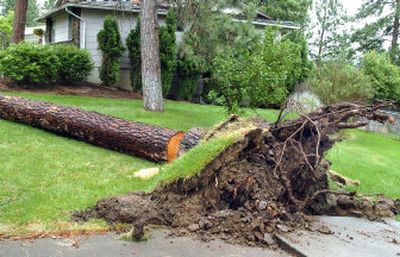Downed tree is big problem

Tom Simonich didn’t spend the Saturday after the big windstorm on June 21 doing what he’d planned. He spent it looking for a replacement for his mountain ash which was turned to little more than kindling by a 30-foot pine, uprooted by the wind. On its way down, the tree also took out several medium-sized bushes and punched a hole in a sprinkler line. And it wasn’t even his tree.
“The wind was blowing and my daughter heard it come down and thought it was ours. But it was the neighbor’s,” he says.
The neighbor didn’t lose any plants but when the tree roots came out of the ground, they tore up a section of his concrete driveway.
The tree that fell was an accident waiting for the right wind gust to happen.
When his neighbor’s driveway was put in many years ago, some of the tree’s surface support roots were severed to lay the concrete and to create a lawn. Even though many years had died since the construction, the tree’s support system had been compromised and finally reached its breaking point.
Ben Kapan, a certified arborist with Northwest Plant Healthcare, says storms like this should be a wake-up call for anyone who has trees. Kapan recommends that even if there’s no visible damage to your trees, it’s a good idea to look up into the canopy for cracked branches and dead wood that may need to be removed.
To be certain, have a certified arborist do a hazard assessment. A few dollars spent now may save you a bundle down the road. It cost Simonich’s neighbor $1,200 to get rid of the tree, and it wasn’t covered by insurance.
Kapan ads that, “weak wooded trees, like cottonwoods, Siberian elms, poplars and box elders, should be inspected and pruned regularly (to remove) large deadwood because they do readily break out.”
In reference to our recent storm, Kapan notes that, “we are seeing a lot of problems with trees that have recent construction damage.” This not only includes severed roots as in this case, but also damage done to trunks by construction equipment hitting them.
“We sometimes see trees break at these points,” he says. “If there is a scar on a trunk of any major size, the tree should be inspected by an arborist.”
For a lot of people, the storm damage consisted of large branches being torn off trees resulting in a gaping hole in the trunk. The best thing to do, is clean up the damage and trim the edges of the tear a bit.
“There is really nothing else you can do. We don’t paint the tree (with wound dressing or tree paint) any more,” says Kapan. “Trees don’t heal wounds, they basically wall them off.”
Research has shown that trees naturally protect live wood from any wound, he says.
“The tree is equipped with the necessary processes itself to do that. By sealing a wound (with tree paint), it is thought you could seal in disease agents,” he says.
An arborist might also recommend a special maintenance and feeding program which gets nutrients to the tree to increase its vigor and help it begin the process of compartmentalizing and “healing” the wound, Kaplan says.
He cautions, though, that if the wound is large and there is a possibility that it compromised the structural integrity of the tree, people should have an arborist assess the situation.
Shrubs that were damaged by falling limbs, but still have viable branches, can be trimmed and then treated to some tender loving care with extra water for the rest of the summer and into the fall. While trees and branches were casualities of the wind, the gardens they once shaded will likely become causalities without some help through the rest of the summer. For the long term, it may be necessary to think about relocating the garden to a shadier place. Unfortunately, now is not the best time to move perennials and shrubs around in the yard.
So as a short term plan, create some shade for exposed plants with sheets, burlap or commercial shade cloth strung up on poles. Pay close attention to providing afternoon shade, and extra water through the rest of the growing season. You can move plants in September when the weather cools.
Burlap and shade cloth are available by the foot at garden stores like Northwest Seed and Pet or by mail order.